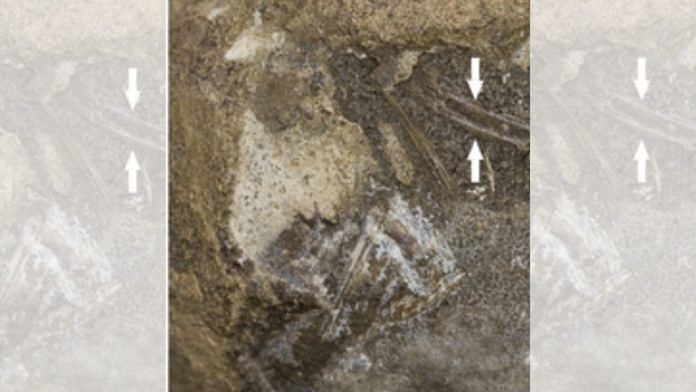New Delhi: A team of researchers from China and Canada has identified a turtle egg fossil from somewhere between 66 million and 145 million years ago that contains an embryo.
Finding the eggs of dinosaurs or turtles from that period, known as the Cretaceous period, is extremely rare since eggs are fragile and do not typically survive even in prime conditions.
Finding a fossilised embryo still inside such an egg is even more rare.
This particular egg was discovered by a farmer who had inadvertently dug up several strange-looking rocks. One of those rocks turned out to be a turtle egg.
The researchers found that the egg was from a turtle that had belonged to a land-dwelling species. The species had been wiped out by the same asteroid impact that killed dinosaurs.
The researchers suggest that the ancient turtle likely was not much different from modern turtles, with one exception — an extremely thick eggshell. Read more
Also read: Scientists discover 1,600-yr-old mummy of a sheep, & seismometres can trace wandering elephants
Rattlesnakes trick humans into thinking they are closer to danger
The sound of the rattlesnake’s tail has evolved to trick humans and animals into thinking that the snakes are closer than they actually are. The rattlesnakes do this by increasing their rattling rate as potential threats approach.
Boris Chagnaud, a researcher at the University of Graz in Austria, was visiting an animal facility when he noticed that the rattling increased in frequency when he approached rattlesnakes but decreased when he walked away.
Based on this observation, Chagnaud and his team conducted experiments in which objects appeared to move toward rattlesnakes. As the potential threats approached, the rattling rate increased to approximately 40 Hz and then abruptly switched to an even higher frequency range, between 60 and 100 Hz.
To test how this change in rattling rate is perceived by others, the researchers designed a virtual reality environment in which 11 participants were moved through a grassland toward a hidden snake. Its rattling rate increased as the humans approached. The listeners were asked to indicate when the sound source appeared to be 1 meter away.
The sudden increase in rattling frequency caused the participants to underestimate their distance to the virtual snake.
The research shows that snakes do not just rattle to advertise their presence, but have evolved to have a sonic distance warning device similar to the one included in cars while driving backwards.
The study shows as mammals evolved to develop auditory perception, the snake’s rattling also co-evolved, allowing snakes that were best able to avoid being stepped on to survive. Read more
Earth’s magnetic field weakens every 200 million years
Scientists have found further evidence to show that the strength of the Earth’s magnetic field has an approximately 200 million-year-long cycle.
Researchers from the University of Liverpool performed thermal and microwave analysis on rock samples from ancient lava flows in Eastern Scotland to measure the strength of the geomagnetic field during key time periods.
The study also analysed the reliability of all of the measurements from samples from 200 to 500 million years ago, collected over the last 80 years.
The team found that between 332 and 416 million years ago, the strength of the geomagnetic field preserved in these rocks was less than a quarter of what it is today, and similar to a previously identified period of low magnetic field strength that started around 120 million years ago.
The study supports the theory that the strength of the earth’s magnetic field is cyclical, and weakens every 200 million years. Read more
Widest coral discovered in Australia’s Great Barrier Reef
Researchers have discovered the widest known coral at Australia’s Great Barrier Reef, measuring as much as 10.4 meters.
The coral has been named ‘Muga dhambi’, which translates to Big Coral, by the traditional custodians of the Islands, the Manbarra people. The Manbarra are custodians of the Palm Islands, Magnetic Island, and an area of mainland Queensland.
The ancient coral was found off the coast of the Palm Islands. It has survived coral bleaching, invasive species, cyclones, and human activities for almost 500 years.
Muga dhambi is also the sixth tallest coral measured in the Great Barrier Reef, at 5.3 meters. Based on the colony’s height, the team estimates it to be between 421 and 438 years old.
Given that the corals at the Great Barrier Reef are experiencing significant damage and bleaching due to global warming, scientists believe that studying Muga dhambi may help reveal what makes corals resilient. Read more
Increased snowfall to counter sea level rise in Antarctica
A new study this week predicts that any sea level rise in Antarctica will be countered by an increase in snowfall, associated with a warmer polar atmosphere.
Using modern methods to calculate projected changes to sea levels, researchers discovered that the two ice sheets of Greenland and Antarctica respond differently, reflecting their very distinct local climates.
The research is based on the new generation of climate models which are used in the latest Intergovernmental Panel on Climate Change (IPCC) report.
The researchers found that there is very little change in projected sea level rise from the Antarctic ice sheet. This is because increased mass loss triggered by warmer oceans is countered by mass gain by increased snowfall, which is associated with the warmer polar atmosphere.
However, the same is not true for the North pole, where global warming and subsequent melting of ice will lead to a sea level rise.
The recent findings suggest that society should plan for higher sea levels, and match with virtually all previous estimates of sea level rise — in that scientists expect sea levels to continue to rise well beyond 2100, most likely at an accelerating rate. Read more
(Edited by Manasa Mohan)
Also read: How climate is changing our body size, and why our ‘brains are shrinking’



